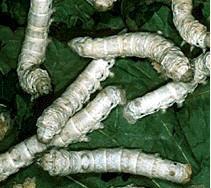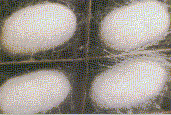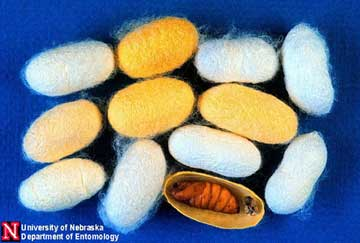

Spinning
a Cocoon
The silk is actually hardened silkworm saliva. It comes out of
the mouth, not out of the rear end like a spider. When the silkworm ate great quantities
of mulberry leaves, they were digested and nutrients were sent into the bloodstream. The
silk glands absorbed these nutrients. The larva has a small spinneret on its lip, through
which the silk emerges. The single strand of silk that forms the cocoon is about one mile
long! 
The silkworm moves its head in figure 8 patterns as it spins the cocoon. When the cocoon is partially made, you can see the head moving around inside if you hold it up to the light as shown at the left.
 Finished cocoons are opaque and about two inches long. Silkworm
farmers place cardboard grids near the silkworms. The silkworms spin their cocoons
inside these frames.
Finished cocoons are opaque and about two inches long. Silkworm
farmers place cardboard grids near the silkworms. The silkworms spin their cocoons
inside these frames.

To continue to the next stage of development, click on Becoming a moth.